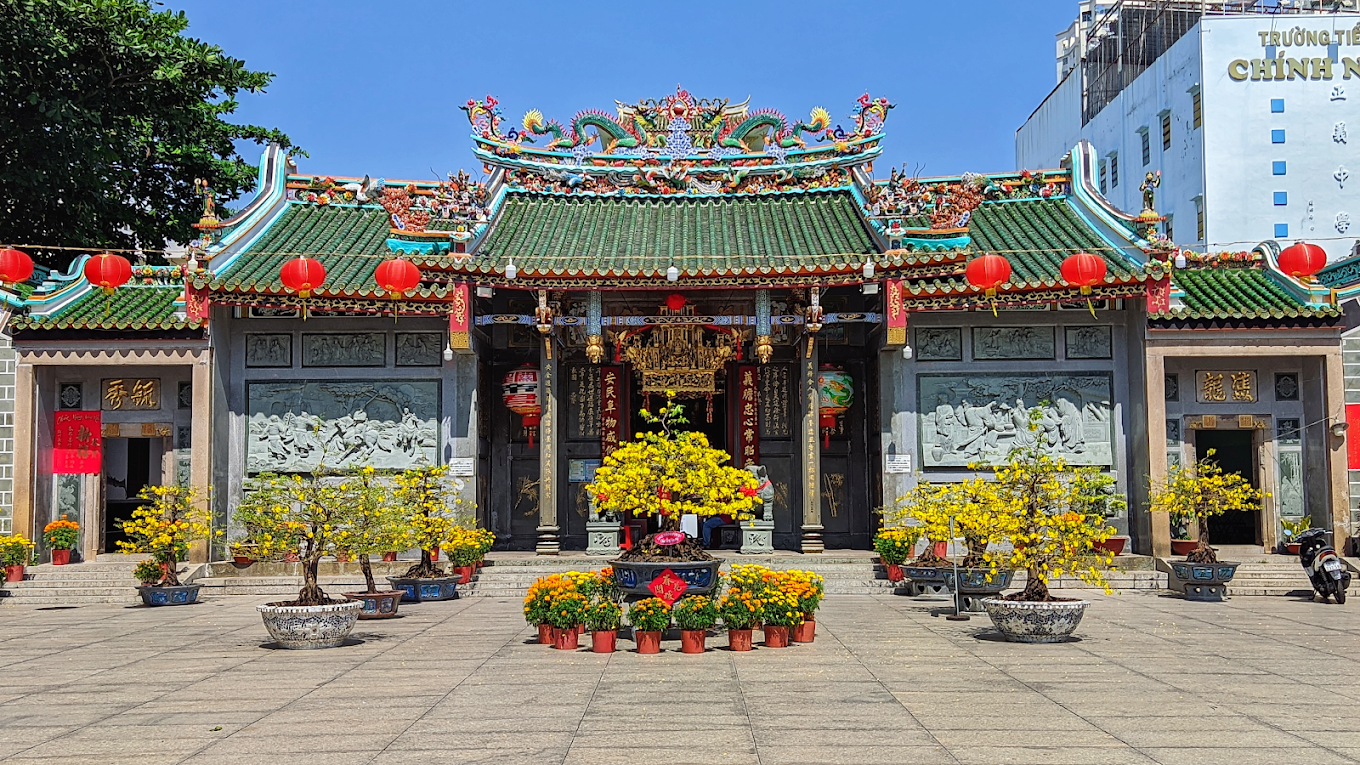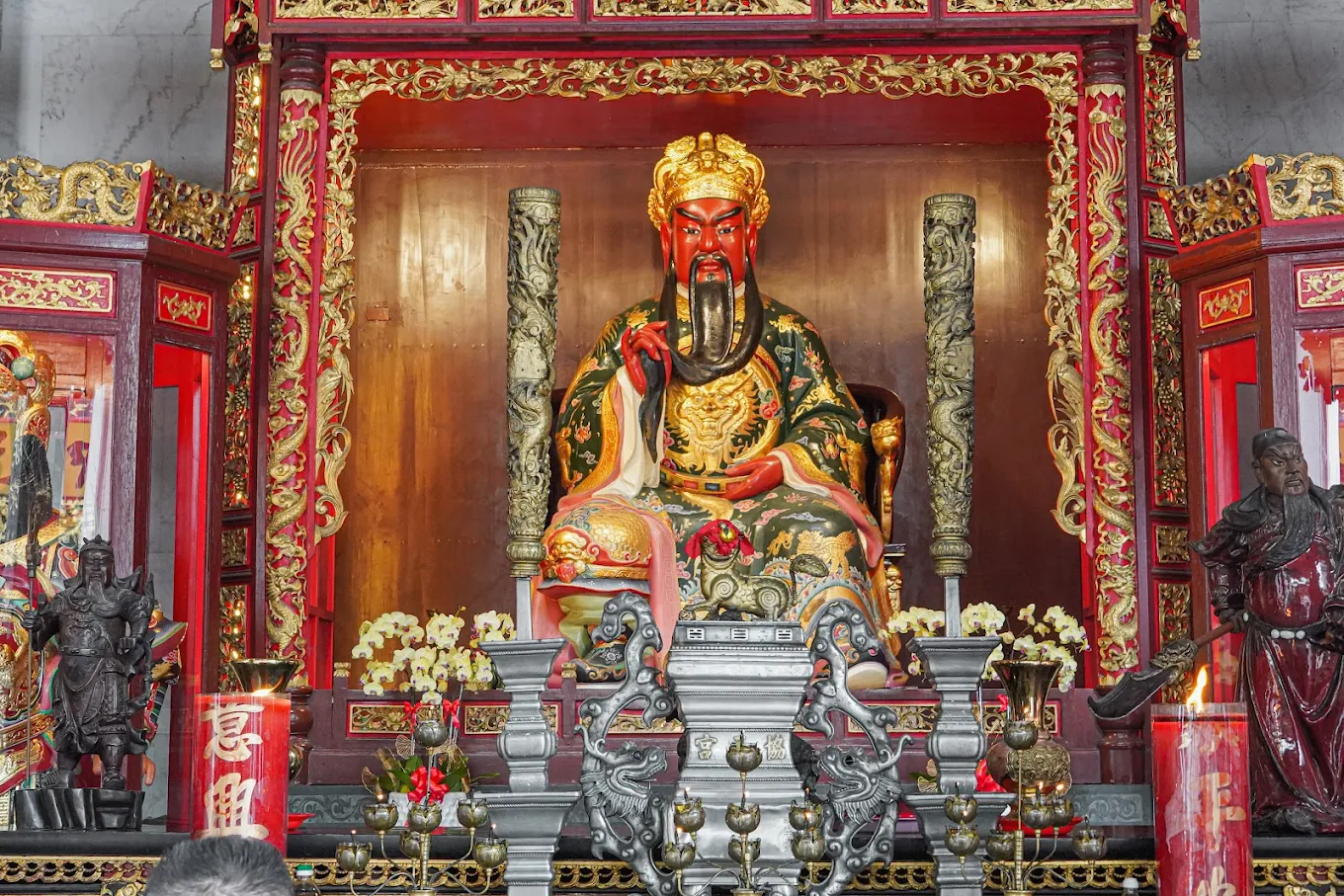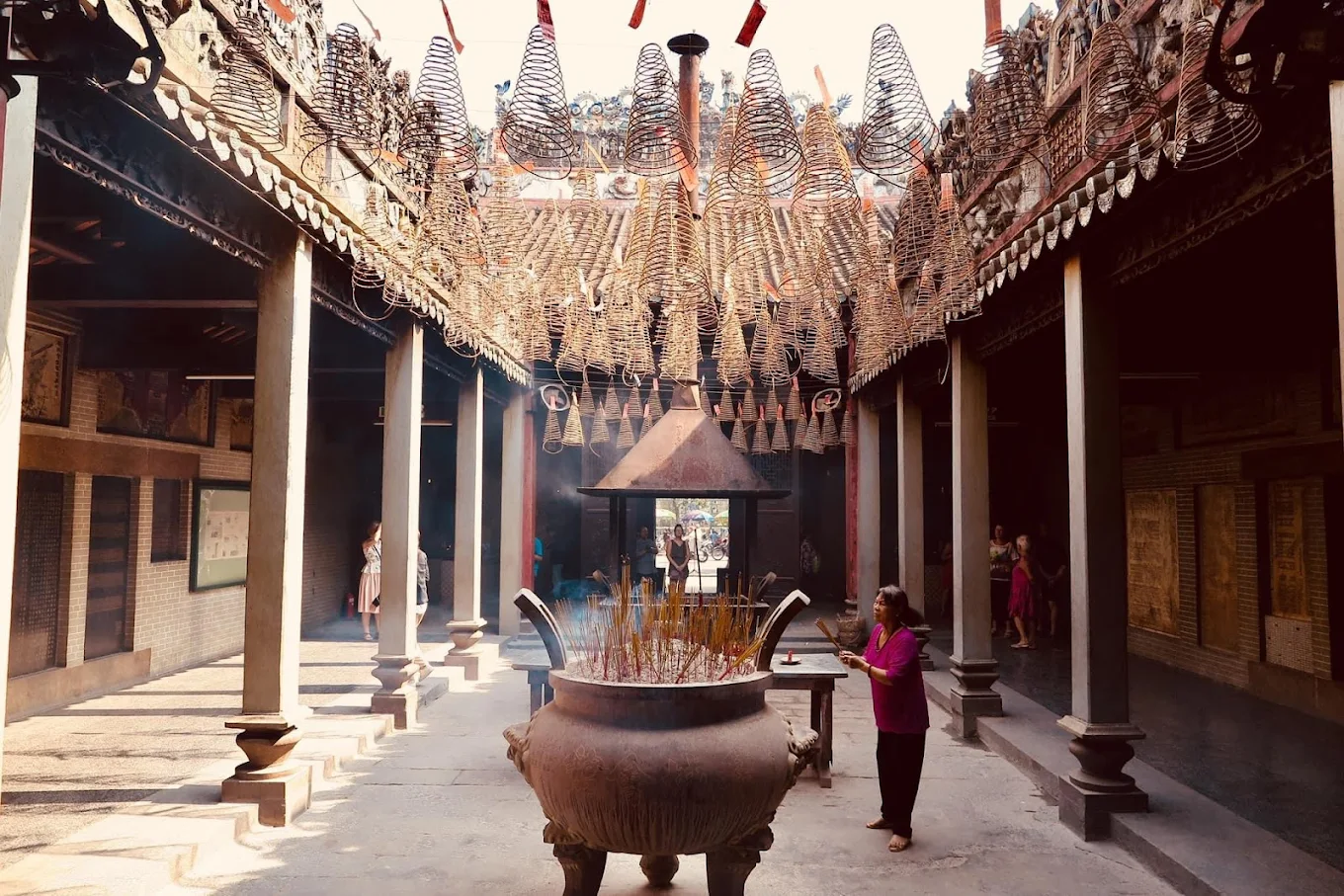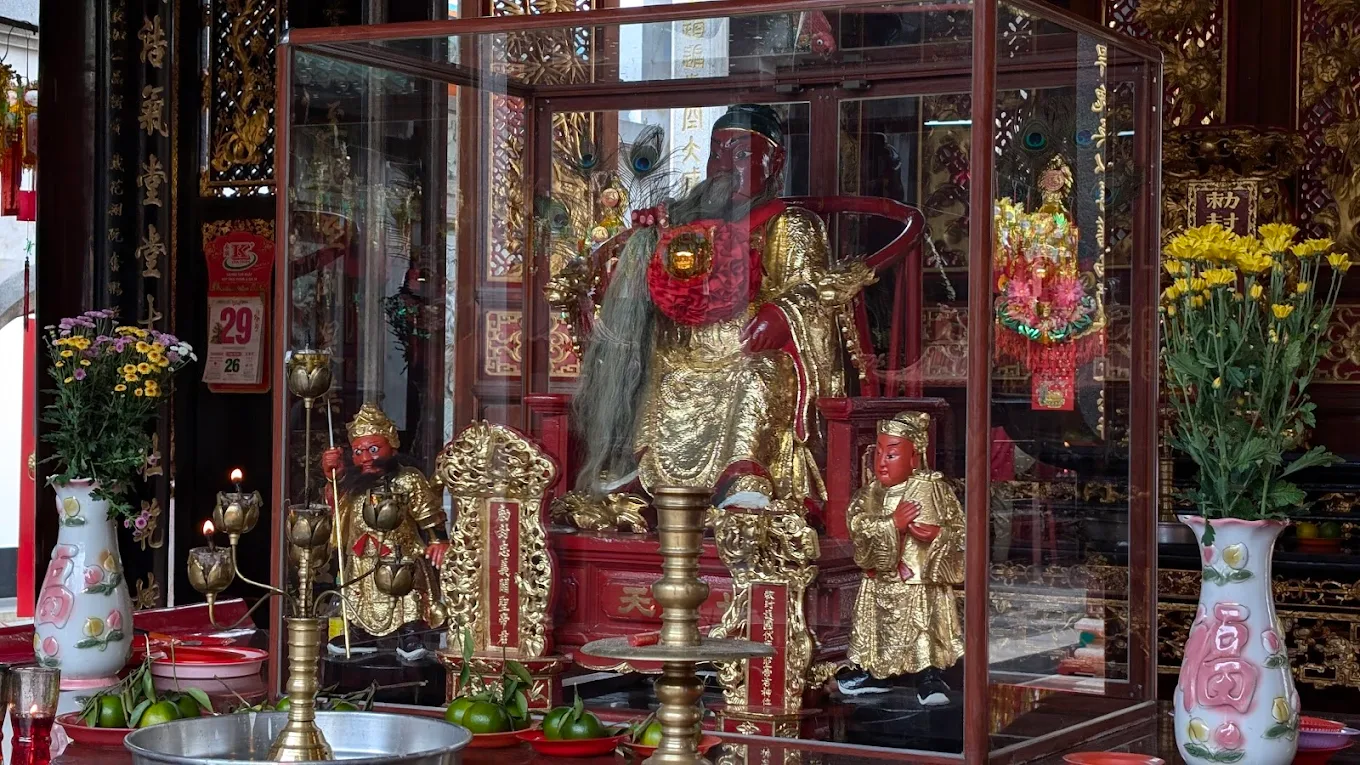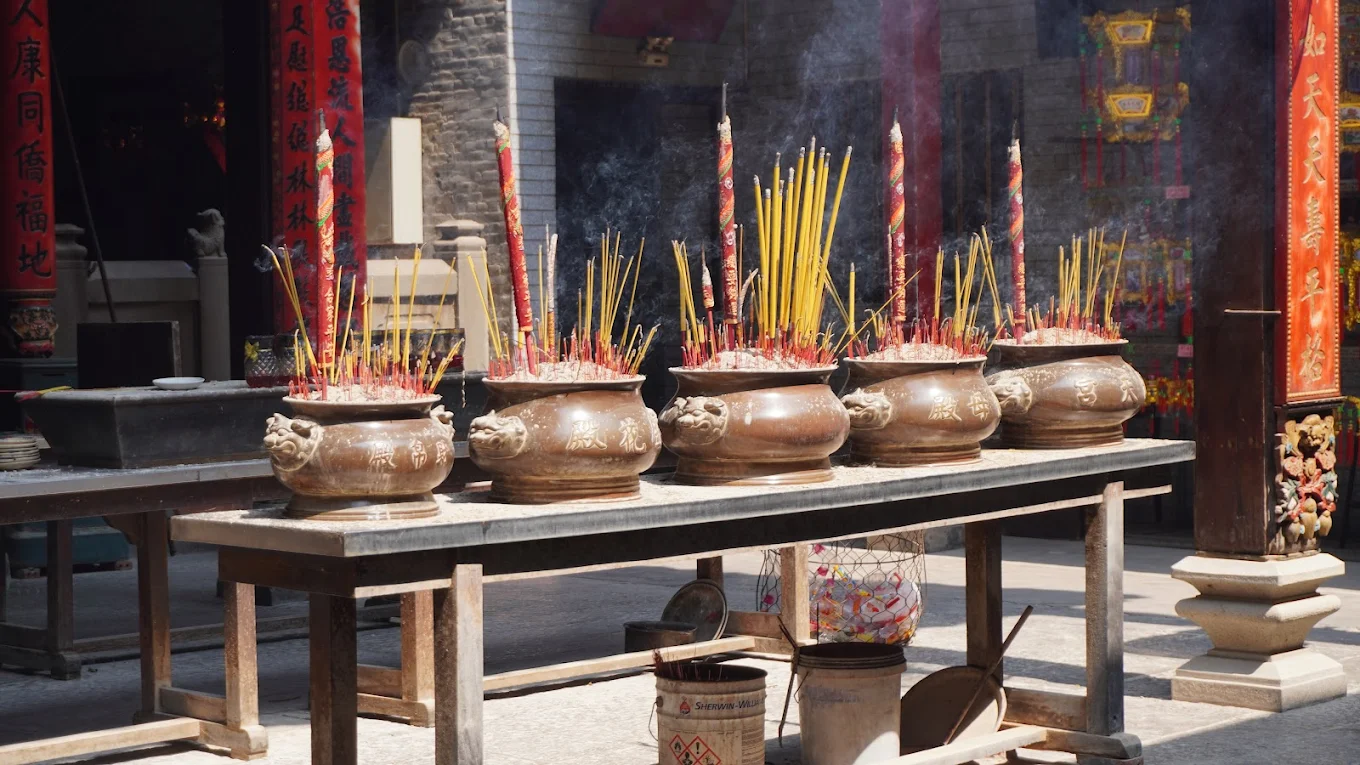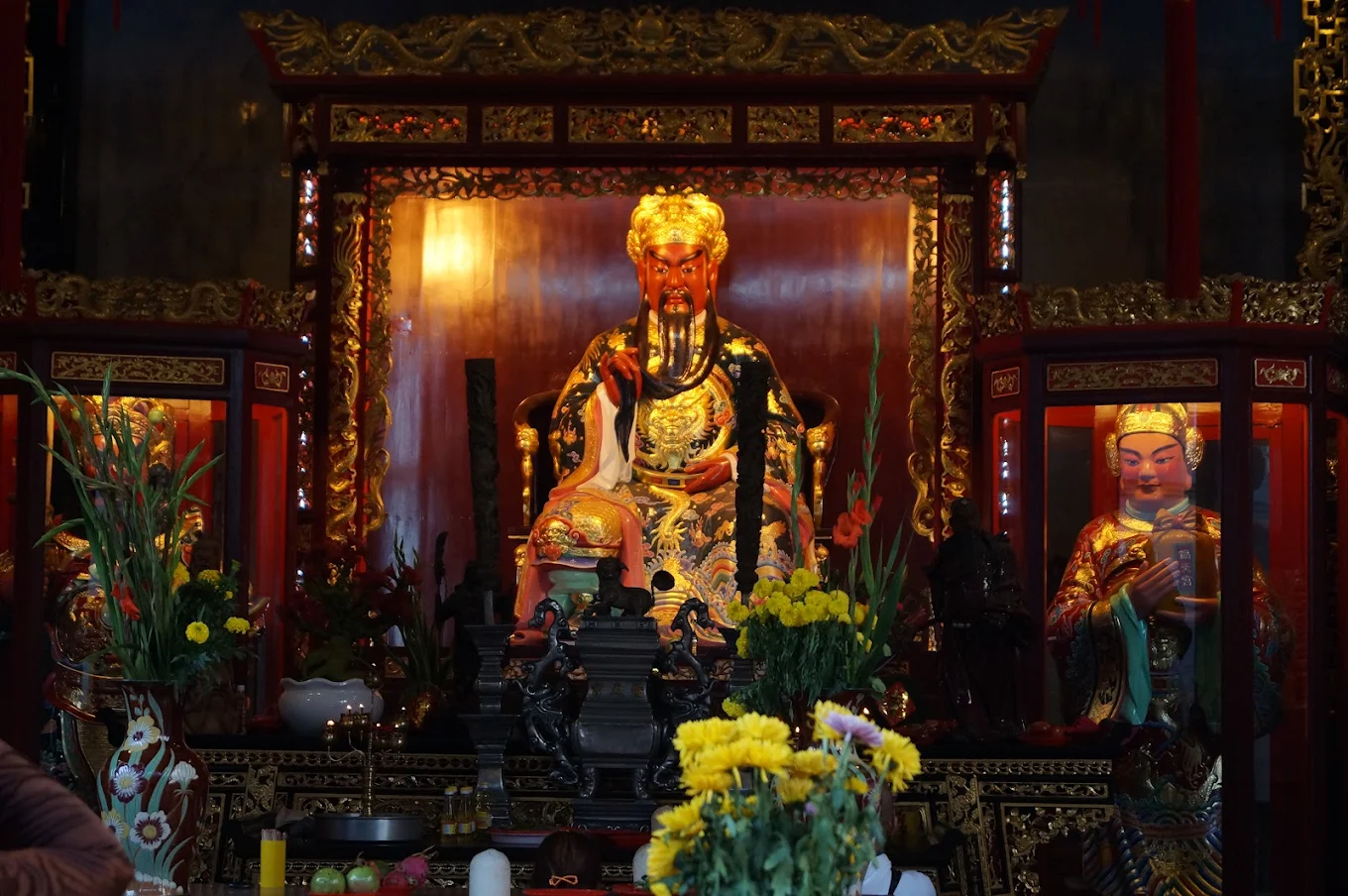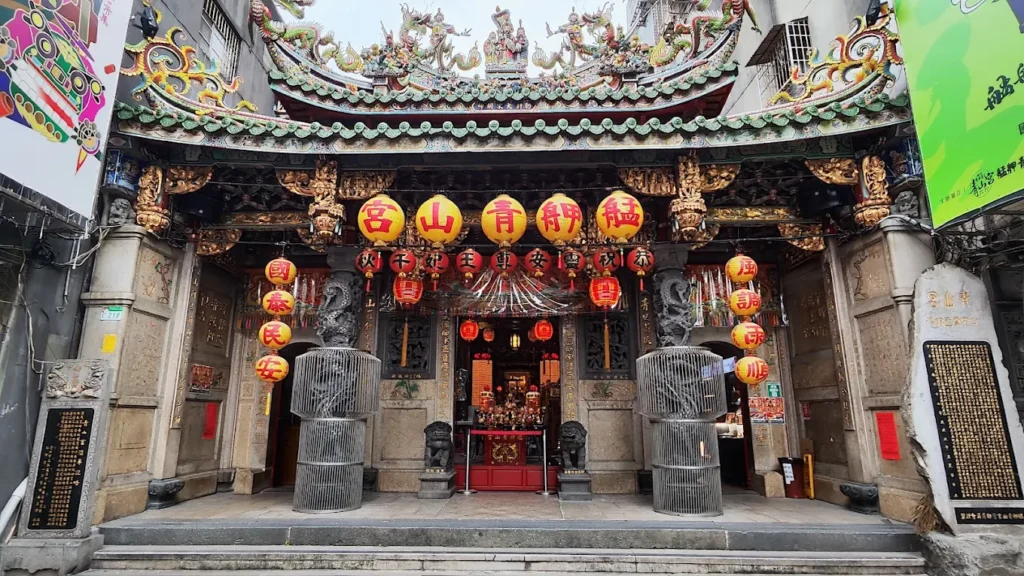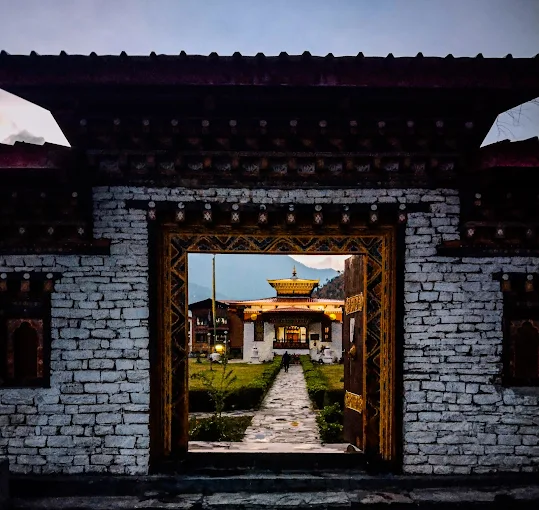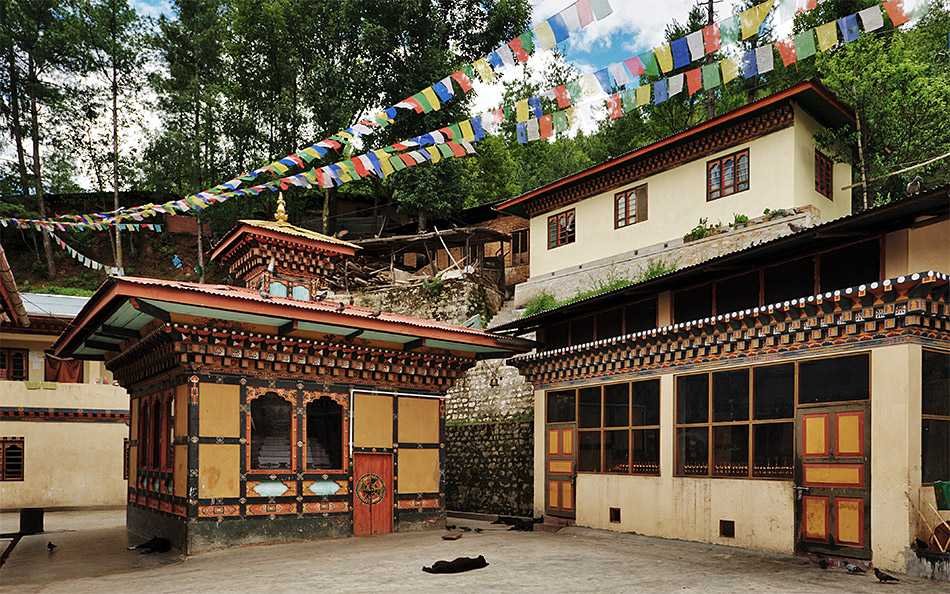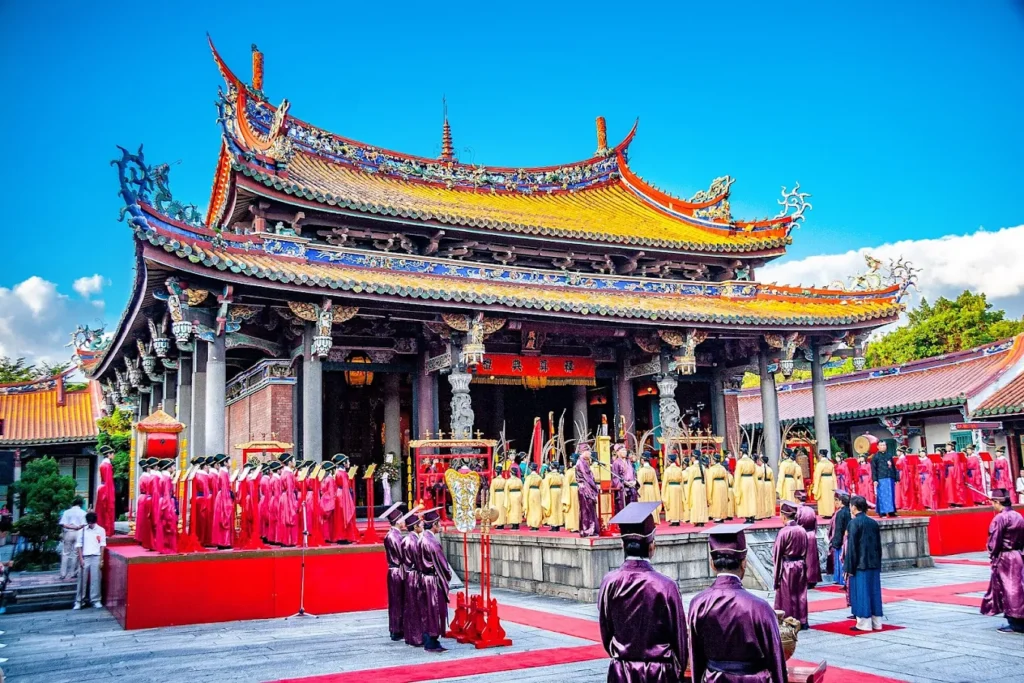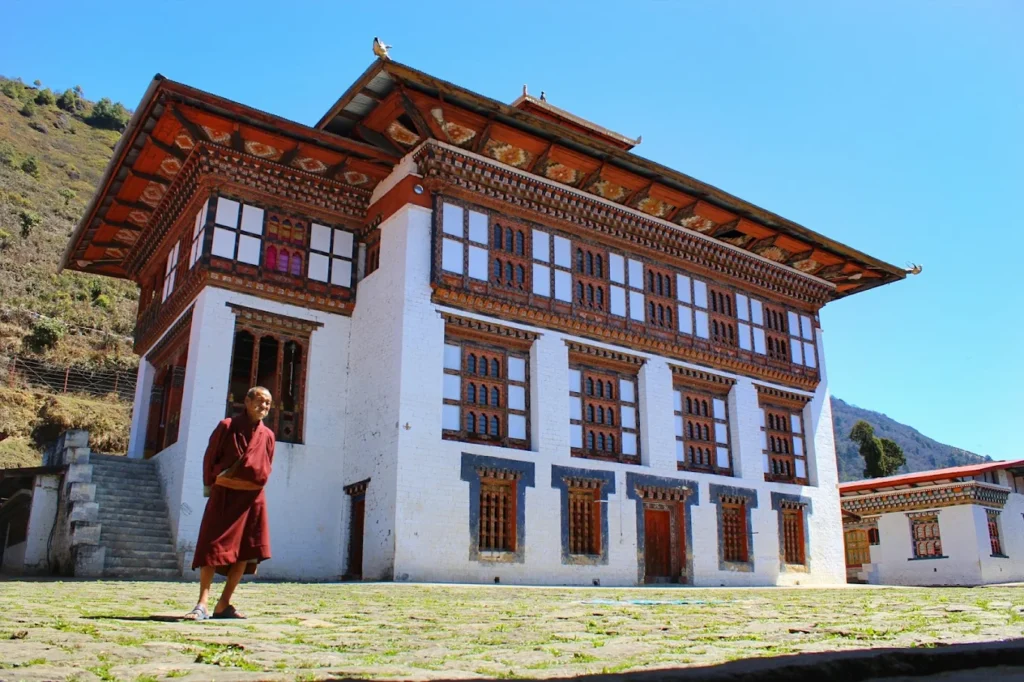Nghĩa An Pagoda: The Teochew Sanctuary of Martial Devotion
In the vibrant heart of Chợ Lớn, incense swirls from Nghĩa An Pagoda, its red-tiled roofs glowing under Ho Chi Minh City’s sun. This 19th-century Teochew temple, adorned with a grand wooden boat relief over its gate, radiates reverence for Quan Công [Guan Yu], whose red horse statue stands proudly. Founded by Chaozhou immigrants, its courtyards hum with prayers and the soft chime of a bronze bell, blending Taoist devotion with Buddhist serenity. Intricate dragon-horse carvings and vibrant murals weave tales of loyalty, from the Goddess of Mercy to the God of Happiness and Virtue. Amid District 5’s bustling markets, Nghĩa An Pagoda stands as a tranquil haven, inviting exploration of its sacred artistry and Teochew heritage.
Overview and Significance of Nghĩa An Pagoda
Nghĩa An Pagoda anchors District 5’s Teochew community, weaving Chaozhou Taoist traditions into Chợ Lớn’s multicultural tapestry. Established in the early 19th century by immigrants from Chaozhou, Guangdong Province, it serves as a temple and guildhall, honoring martial and virtuous ideals. Guan Yu, revered as a deified warrior, anchors its spiritual core, while the Goddess of Mercy and the God of Happiness and Virtue enrich its syncretic worship. Its Teochew architecture, with a boat relief and red horse statue, hosts vibrant festivals that unite locals. This exploration unveils Nghĩa An Pagoda’s history, cultural resonance, and enduring legacy in Ho Chi Minh City.
Introduction to Nghĩa An Pagoda
Nestled in District 5, Nghĩa An Pagoda embodies Teochew heritage. Known as Hội Quán Nghĩa An, it reflects the martial spirit of Chaozhou immigrants. Quan Công [Guan Yu], revered as a Three Kingdoms warrior deified for loyalty, draws devotees with incense and offerings. His red horse statue, symbolizing valor, stands as a testament to Teochew devotion. Alongside him, the Goddess of Mercy and the God of Happiness and Virtue form a syncretic pantheon, blending Taoist and Buddhist reverence in Chợ Lớn’s vibrant landscape.
Historical Journey
Nghĩa An Pagoda emerged in the early 19th century, likely around 1810, founded by Teochew immigrants as a communal sanctuary. Renovations in 1860 and 1900 preserved its structure through colonial and modern eras. The wooden boat relief, carved in 1860, marks its cultural significance. Key milestones include:
- 1810: Founded as Hội Quán Nghĩa An.
- 1860: Restored with the iconic boat relief and red horse statue.
- 1900: Expanded courtyard and added dragon carvings.
Cultural Significance
Nghĩa An Pagoda anchors Chợ Lớn’s cultural tapestry, uniting Teochew and Vietnamese communities. Annual festivals, like the Quan Công Ceremony on the 13th day of the first lunar month, feature lion dances and offerings. The Hungry Ghost Festival [Cúng Cô Hồn] fosters charity with food for wandering spirits. Its role in community gatherings amplifies Nghĩa An Pagoda’s cultural resonance, drawing devotees to its sacred halls.
Unique Legacy
The pagoda’s legacy lies in its martial worship and Teochew artistry. Guan Yu’s red horse statue, paired with the wooden boat relief symbolizing community protection, sets it apart. Intricate woodwork and straight roofs, distinct from Cantonese or Hainanese designs, make Nghĩa An Pagoda a beacon of cultural pride in District 5.
Community and Global Impact
Nghĩa An Pagoda connects Teochew communities across Vietnam and Southeast Asia, hosting cultural exchanges. Locally, it organizes festivals and charity drives, strengthening District 5’s social bonds. Globally, pilgrims from Chaozhou visit to honor Guan Yu, amplifying Nghĩa An Pagoda’s influence within the diaspora.
Historical Anecdotes
Elders recount a merchant gaining courage after praying to Guan Yu, crediting his success to the warrior’s spirit. Another tale describes a Teochew artisan carving the boat relief in 1860, embedding prayers for community unity. These stories weave devotion into Nghĩa An Pagoda’s legacy, resonating in Chợ Lớn’s oral traditions.
Social Role
Nghĩa An Pagoda serves as a community hub, hosting cultural workshops and charity events. During the Hungry Ghost Festival, it distributes food to the needy, embodying Taoist compassion. Its open courtyards welcome all, fostering inclusivity in Chợ Lớn’s vibrant neighborhood.
Artistic Influence
The pagoda’s dragon-horse carvings and boat relief inspire Chợ Lớn’s murals and local art. Its Teochew aesthetic, with vibrant woodwork and ceramic accents, shapes District 5’s visual culture, distinct from Buddhist pagodas’ stone-heavy designs. Nghĩa An Pagoda’s artistry enriches its creative legacy.
Nghĩa An Pagoda’s history, steeped in Teochew devotion, shapes its architectural splendor. Its boat relief and red horse statue, crafted with ancestral skill, set the stage for exploring Nghĩa An Pagoda’s design and spiritual essence.
Architectural and Spiritual Features
Nghĩa An Pagoda’s architecture, a masterpiece of Teochew design, radiates in District 5 with red-tiled roofs and a grand boat relief. Spanning 900 square meters, its layout—courtyard, front hall, main shrine—guides worshippers toward reverence. Guan Yu’s altar, with its red horse statue, anchors its spiritual core, joined by the Goddess of Mercy and the God of Happiness and Virtue. Dragon-horse carvings and vibrant murals, distinct from Cantonese or Hainanese temples, tell tales of loyalty and virtue. This exploration unveils Nghĩa An Pagoda’s artistry and sacred features.
Iconic Design
Nghĩa An Pagoda follows Teochew design, with a three-door gate [tam quan] opening to a 200-square-meter courtyard. Its red exterior, symbolizing prosperity, contrasts with straight roofs, evoking stability. The layout, unlike Buddhist Quốc-shaped designs, creates a serene ascent toward the main shrine.
Key Structures
The pagoda includes:
- Courtyard: Wide, with stone unicorns and incense burners, fostering calm.
- Front Hall [tiền điện]: Houses the God of Happiness and Virtue’s altar and calligraphy boards.
- Side Halls: Worship the Goddess of Mercy and Dharma Protectors, framing the courtyard.
- Main Shrine [chánh điện]: Dedicated to Guan Yu, the main hall glows with gold.
Worshipped Statues/Deities
Key deities include:
- Quan Công [Guan Yu]: A 1.5-meter wooden statue, with a black beard and red horse, honors Guan Yu, a Three Kingdoms warrior deified for loyalty. His altar, central to Teochew devotion, draws offerings of incense, embodying martial virtue. Devotees pray for courage, blending Taoist and Buddhist reverence.
- Quan Âm [Goddess of Mercy]: A 1.3-meter white jade statue, representing Avalokiteshvara, embodies Buddhist compassion. Devotees seek her blessings for peace, complementing the pagoda’s Taoist core. Her serene presence, rooted in Mahayana teachings, fosters solace and reflection.
- Ông Bổn [God of Happiness and Virtue]: A 1-meter statue in a glass altar, symbolizing prosperity and virtue, draws prayers for well-being, a unique Teochew devotion.
Materials and Techniques
Artisans used jackfruit wood [gỗ mít] for beams, valued for durability, and red lacquer for panels. Straight roof tiles, imported from Chaozhou, withstand tropical rains. Gilded wood carvings, crafted in 1860, showcase Teochew artistry, distinct from Buddhist stonework.
Signature Elements
The wooden boat relief above the entrance, carved in 1860, depicts community protection, symbolizing Teochew unity. The red horse statue of Guan Yu, unique to Nghĩa An Pagoda, stands as a martial emblem in District 5.
Lesser-Known Features
Subtle details include:
- Long Mã [Dragon-Horse] Carvings: Wall reliefs of dragon-horses, mythical creatures symbolizing strength and divine favor, reflect Teochew mythology. These intricate carvings enhance the pagoda’s spiritual depth.
- Calligraphic Boards: Inscriptions from 1810, exuding Taoist wisdom.
- Incense Coils: Ceiling-hung, burning for weeks, creating a sacred haze.
Preservation Efforts
Restorations in 1860 and 1900 reinforced the roof and reliefs, using Teochew techniques. Community-funded repairs preserve the woodwork, ensuring Nghĩa An Pagoda’s structural beauty endures.
Environmental Integration
The courtyard’s feng shui [phong thủy] alignment channels positive energy, cooling the halls with breezes. Its urban setting in Chợ Lớn grounds Nghĩa An Pagoda’s spiritual harmony amid bustling markets.
Artisan Narratives
A Teochew artisan carved the boat relief in 1860, embedding Taoist blessings. His descendants maintain the pagoda, their stories weaving craftsmanship with devotion, enriching Nghĩa An Pagoda’s heritage.
Symbolic Details
Red hues signify prosperity, straight roofs stability. The Dragon-Horse carvings, symbolizing divine strength, complement Guan Yu’s martial devotion, distinct from Cantonese or Hainanese designs in Chợ Lớn.
Landscape Integration
Stone pathways and potted plants in the courtyard foster meditation. Surrounded by District 5’s markets, Nghĩa An Pagoda’s tranquil oasis contrasts with guildhall temples, amplifying its spiritual allure.
Nghĩa An Pagoda’s architecture, from boat reliefs to the red horse statue, supports its vibrant rituals. These practices, centered on Guan Yu and syncretic deities, bring the pagoda’s spiritual essence to life, inviting exploration of Nghĩa An Pagoda’s ceremonies.
Rituals and Practices
Nghĩa An Pagoda’s rituals embody Teochew Taoist traditions, with Guan Yu’s martial blessings at their core. Daily incense offerings fill the air, while festivals like the Quan Công Ceremony draw crowds with vibrant ceremonies. These practices, woven with devotion, reflect the pagoda’s role as Chợ Lớn’s spiritual heart. From martial rites to communal celebrations, this exploration unveils Nghĩa An Pagoda’s sacred customs.
Daily Sacred Rites
Each dawn, devotees light incense at Guan Yu’s altar, praying for courage. Monks chant Taoist scriptures, their voices mingling with the bell’s chime. Evening offerings to the Goddess of Mercy seek compassion, creating a tranquil rhythm in District 5.
Unique Practices
Devotees offer red candles to Guan Yu, seeking strength and loyalty—a Teochew custom. Prayers to the God of Happiness and Virtue for prosperity, unique to Nghĩa An Pagoda, reflect its Chaozhou roots, distinct from maritime rites of nearby guildhalls.
Festival Traditions
Key festivals include:
- Quan Công Ceremony: On the 13th day of the first lunar month, lion dances and offerings honor Guan Yu’s martial spirit.
- Hungry Ghost Festival [Cúng Cô Hồn]: On the 15th day of the seventh lunar month, roasted pig [heo quay] offerings appease wandering spirits.
- Lantern Festival [Tết Nguyên Tiêu]: On the 15th day of the first lunar month, lanterns light the courtyard.
Visitor Engagement
Visitors join daily prayers, lighting incense under monk guidance. During the Quan Công Ceremony, guests offer candles, immersing in Teochew traditions, enriching their experience at Nghĩa An Pagoda.
Spiritual Community Roles
Monks lead rituals, while lay practitioners [cư sĩ], often elders, maintain Guan Yu’s altar, reflecting Teochew devotion. These devotees organize festivals, blending spirituality with service.
Interfaith Connections
Nghĩa An Pagoda blends Taoist and Buddhist elements, with the Goddess of Mercy’s altar attracting Vietnamese worshippers. This syncretism, quieter than Bà Thiên Hậu Pagoda, broadens its spiritual appeal in Chợ Lớn.
Ritual Symbolism
Red candles symbolize loyalty in Guan Yu’s rites, incense harmony. The Dragon-Horse carvings, reflecting divine strength, enhance the pagoda’s rituals, rooted in Teochew mythology.
Seasonal Variations
Spring festivals emphasize martial blessings, drawing devotees to Guan Yu’s altar. Autumn rites focus on ancestral worship during the Hungry Ghost Festival, adapting to seasonal spiritual needs.
Monastic/Community Life
Monks meditate and maintain altars, living simply. Lay practitioners volunteer for charity, reinforcing Nghĩa An Pagoda’s role as a community hub, distinct from Buddhist-centric pagodas.
Nghĩa An Pagoda’s rituals, from incense offerings to vibrant festivals, invite visitors to engage with its spiritual heart. Practical guidance for exploring these practices enhances the journey, as detailed in Nghĩa An Pagoda’s visitor information.
Visitor Information
Nghĩa An Pagoda offers a tranquil escape in District 5, easily accessible for spiritual exploration. From navigating Chợ Lớn’s vibrant streets to respecting Taoist customs, this guide provides logistics, excluding pricing, to deepen your experience at Nghĩa An Pagoda.
Navigating to Nghĩa An Pagoda
From District 1’s Bến Thành Market, travel west on Lê Lợi Street, then south on Nguyễn Trãi toward Chợ Lớn. The pagoda sits at 678 Nguyễn Trãi, its boat relief and red horse statue marking its presence amidst bustling markets.
Address of Nghĩa An Pagoda
The pagoda is located at 678 Nguyễn Trãi Street, Ward 11, District 5, Ho Chi Minh City, Vietnam.
Visiting Hours and Etiquette
Open daily from 6:00 AM to 6:00 PM, Nghĩa An Pagoda welcomes visitors year-round. Wear modest clothing, covering shoulders and knees, and remove shoes in the main hall. Silence phones and speak softly to honor worshippers.
Transport Options
Reach Nghĩa An Pagoda by:
- Motorbike: Common in District 5, with nearby parking.
- Taxi or Grab: A 15-minute ride from District 1.
- Bus: Route 1 or 54 from Bến Thành to Triệu Quang Phục, then a 5-minute walk to Nguyễn Trãi.
- Walking: Feasible from nearby Quảng Triệu Pagoda.
Accessibility and Safety
Flat pathways aid wheelchair access, though the main shrine has steps. Watch for motorbike traffic on Nguyễn Trãi Street. Stay hydrated in Ho Chi Minh City’s humidity and secure valuables in crowded areas.
Amenities and Surroundings
The courtyard offers restrooms and seating. Nearby tea stalls and phở shops provide refreshments. Chợ Lớn’s Bình Tây Market, a short walk away, adds vibrant post-visit exploration.
Immersive Visitor Tips
Visit at dawn for quiet prayers or during the Quan Công Ceremony for lively rituals. Light red candles at Guan Yu’s altar, guided by monks, and study the boat relief to appreciate Teochew artistry.
Nearby Cultural Experiences
Explore:
- Quảng Triệu Pagoda: Cantonese temple, 5 minutes away.
- Bình Tây Market: Historic market for local goods.
- Hội Quán Hà Chương: Fujianese temple with dragon pillars.
Photography Tips
Photography is permitted, but avoid flash near altars. Capture the boat relief and red horse statue from the courtyard. Respect worshippers by not photographing active prayers.
Nghĩa An Pagoda’s rituals and architecture reveal its spiritual depth, but its philosophical and community insights deepen the experience, inviting reflection on its significance.
Cultural and Spiritual Insights
Nghĩa An Pagoda’s Teochew Taoist roots, blended with Buddhist elements, shape its cultural and spiritual resonance. Its martial worship and community resilience reflect Chợ Lớn’s multicultural spirit. These insights illuminate Nghĩa An Pagoda’s philosophical and symbolic role.
Religious Philosophy
Taoism at Nghĩa An Pagoda emphasizes loyalty, with Guan Yu embodying martial virtue. Devotees seek balance through prayers, blending Buddhist compassion. This philosophy fosters courage, drawing worshippers to the pagoda’s altars.
Environmental Spirituality
The courtyard’s feng shui alignment channels positive energy, fostering calm amid urban bustle. Its urban setting in Chợ Lớn enhances spiritual harmony, reflecting Taoist reverence for nature, unique to Teochew design.
Artistic Symbolism
Dragon-Horse carvings symbolize divine strength, boat reliefs community protection. These Teochew motifs, rooted in Chaozhou mythology, distinguish Nghĩa An Pagoda from Buddhist pagodas, enriching its artistic legacy.
Community Resilience
Teochew donations for restorations showcase devotion. Festival charity, like food distribution during the Hungry Ghost Festival, embodies Taoist generosity, strengthening District 5’s bonds.
Environmental Stewardship
Sustainable practices, like rainwater collection in the courtyard, reflect Taoist respect for nature. These efforts preserve Nghĩa An Pagoda’s serene environment, unlike urban-focused guildhalls.
Meditative/Contemplative Practices
Devotees meditate before the Goddess of Mercy’s statue, seeking inner peace. These Taoist and Buddhist mindfulness practices, open to visitors, foster reflection, enhancing the pagoda’s spiritual allure.
Cultural Narratives
Legends of Guan Yu granting courage and the God of Happiness and Virtue bestowing prosperity enrich Chợ Lớn’s oral tradition. These stories tie Nghĩa An Pagoda to Teochew devotion, amplifying its cultural weight.
Historical Context
Nghĩa An Pagoda reflects Chợ Lớn’s 19th-century Teochew migration, blending Chinese and Vietnamese cultures. Its festivals connect to Ho Chi Minh City’s multicultural history, anchoring its regional significance.
Nghĩa An Pagoda’s cultural insights, from Taoist loyalty to Teochew legends, underscore its unique appeal. This enduring legacy, woven with devotion and artistry, beckons exploration.
Why You Have to Visit
Nghĩa An Pagoda’s red-tiled halls and Guan Yu’s red horse statue embody Teochew devotion, offering a window into Chợ Lớn’s cultural heart. Its boat relief, vibrant festivals, and syncretic deities tell a story of loyalty and artistry. From the tranquil courtyard to the incense-filled main hall, the pagoda invites reflection on faith and heritage. Visit to witness a living legacy, where Taoist virtue and Teochew craftsmanship converge in District 5.
